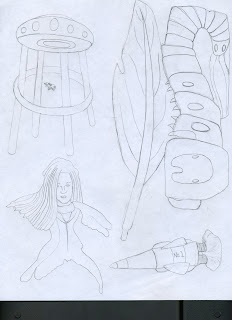1. When did you get you first get published?
Probably just when I graduated, maybe a month after. I had my first job come through for an editorial illustration. That was just about 2 years ago.
2. How do you go about getting published?
It just sort of happens, it was completely out of the blue. I used to think there was a methodical practice to getting work, but there isn't. The best you can do is work hard and make sure your work gets seen, contact potential clients, etc. I just worked and worked and worked and published as much as I could online for clients to see.
3. What kind of clients do you have?
I have a real mix, some editorial, some advertising and some for design based projects.
The biggest repeat clients I've had are for editorial work. Advertising tends to be one off work.
4. Have you ever had a client ask for changes to something that you had done for them or not pay you for the job?
I haven't had anyone not pay, but changes can be quite common. I used to use acrylics to paint most of my work, but now i find myself working digitally because it makes it so much easier to edit.
5. How much do you make on average?
Per Month? At the moment I've been paying myself £800 and spending carefully. All of my jobs are payed into my business account and I have set up a standing order to pay myself a steady amount. I'm trying to make sure I don't run out of money and I'm still learning to balance everything, so that's why I don't pay myself that much. Soon I'm thinking about upping my wage to £1000 and seeing how my business account does. I make a lot more than what I pay myself, but I try not to be greedy. Some weeks will be slim, and I won't make that much, but sometimes I'll work on a job that pays anything from £500-£2000 that keeps me going. I've had a few good jobs that paid £3000 and £6000 that kept me going too, and sometimes if I've had a solo show and people have bought paintings that can bring in a few thousand.
I'm still learning and trying to find a reasonable balance.
6. Have you ever done any work for hire?
Once for an animation company, I was character designing for them and worked on a daily rate. It was a pretty good job, unfortunately there wasn't that much work involved, so it only lasted a few days.
7. What is your current work schedule like?
It's manic. I'm currently balancing a childrens book, a comic series for Nobrow, I have a monthly slot illustrating for a specific magazine as well as other illustration work. On top of that I'm working on a few group shows and charity events and workshops. I'm glad though, because it's helped to prove to myself that I'm making enough money to support myself, and I know that I'm working as hard as I can.
8. While you were in college, did you work as well?
Yeah, I really enjoyed it. Because fees cost so much I wanted to make sure I got the most out of my education and worked as hard as I could. I was determined to start a career in art and illustration after working a few awful dead end jobs.
9. What got you interested in doing what you're doing now?
Reading comics, cartoons, film, band posters, tshirt graphics and lowbrow art. That really inspired me to create art, and I used to make band posters for local bands, and I've always drawn comics. I just always wanted to be paid for it.
10. Did you know what you wanted to do when you were in college?
Not straight away no. I really wanted to paint and draw comics, but I had no idea where that fit in. I looked at a lot of graphic art, and assumed that I wanted to start persuing Graphic Design. I took a foundation degree and had to take illustration classes, and had the whole world of illustration opened up to me. I used to think it was quite dry and outdated, but thats definately not the case.
11. What are you major influences?
Japanese Tokusatsu shows, outsider artists (Henry Darger, Howard Finster, Louis Wain), Bruce Bickford's animations, action figures, pulp fiction and silver age comics and alternative comics. I find a lot of inspiration in the area I live too, rural England, it's very bleak, very sparce and I think it's helped me to develop a unique sense of humour that I have weaved into my artwork.
12. Favorite illustrator?
Gary Baseman and Gary Panter. I can't pick between the two. Their work spreads across into so many different fields and I find that really inspiring. They both produce fine art, comics, animations, editorial work, advertising work, and much more, and I like that they haven't restricted themselves, they take anything on.

















































